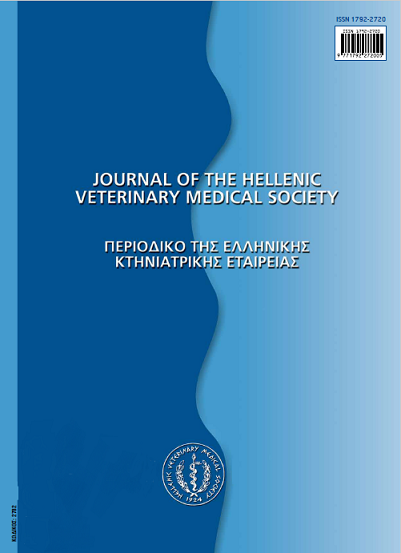An update on meningoencephalomyelitis of unknown aetiology in dogs

Abstract
Inflammatory diseases of the central nervous system are common causes of neurological dysfunction in the dog and can be grouped into two broad categories; those of infectious and those of unknown aetiology. Μeningoencephalomyelitis of unknown aetiology include non-infectious inflammatory central nervous system diseases in which abnormal findings on magnetic resonance imaging and cerebrospinal fluid analysis indicate inflammatory central nervous system disease, but for which histopathological confirmation has not been reached. Meningoencephalomyelitis of unknown aetiology describes a group of non-infectious inflammatory diseases of the central nervous system. These include the granulomatous meningoencephalomyelitis and the necrotising encephalitis, the latter can be further distinguished into two subtypes: necrotising meningoencephalitis and necrotising leucoencephalitis. Steroid-responsive meningitis-arteritis may be also included to this category and, usually, does not present signs of encephalitis or/and myelitis (except in the chronic form) and is easier diagnosed even without histopathological examination. In most cases of meningoencephalomyelitis of unknown aetiology, a presumptive diagnosis can be achieved by the assessment of case presentation, theneurologic signs, cerebrospinal fluid testing, cross-sectional imaging of the central nervous system and appropriate microbiological tests.
Definite diagnosis is achieved with histopathological examination. The underlying cause for these diseases is unknown. The clinical signs in meningoencephalomyelitis of unknown aetiology is variable and depends on which area of the central nervous sytem is affected. Meningoencephalomyelitis is acute in onset, progressive in nature and associated with multifocal to diffuse neuroanatomic localization. Extraneural signs are less common and these usually include pyrexia and peripheral neutrophilia. The differential diagnosis for dogs presented for an acute onset of multifocal central nervous system signs includes genetic abnormalities, metabolic disorders, infectious meningoencephalitis, toxin exposure, stroke and neoplasia.
The diagnostic approach includes a complete blood count, a comprehensive chemistry panel, urinalysis, survey radiographs of the thorax plus abdominal ultrasound to rule out systematic disease and metastatic neoplasia, computed-tomography or magnetic reso meningitisnance imaging, cerebrospinal fluid analysis and microbiological tests.
When neoplasia is suspected, computed-tomography-guided brain biopsy may be required for the differentiation. Meningoencephalomyelitis of unknown aetiology responds more or less to immunosuppressive therapies, but the prognosis should be guarded to poor with the exception of steroid-responsive meningitisarteritis, for which it is good. Treatment protocols are based on prednisolone, but new immunosuppressive agents have now been added in those to control the diseases and they seem to be effective. However, gold standard protocols have yet to be established.
Article Details
- How to Cite
-
CHARALAMBOUS (Μ. ΧΑΡΑΛΑΜΠΟΥΣ) M., DANOURDIS (Τ. ΔΑΝΟΥΡΔΗΣ) T., HATZIS (Α. ΧΑΤΖΗΣ) A., & POLIZOPOULOU (Ζ. ΠΟΛΥΖΟΠΟΥΛΟΥ) Z. S. (2017). An update on meningoencephalomyelitis of unknown aetiology in dogs. Journal of the Hellenic Veterinary Medical Society, 64(2), 131–144. https://doi.org/10.12681/jhvms.15486
- Issue
- Vol. 64 No. 2 (2013)
- Section
- Review Articles
Authors who publish with this journal agree to the following terms:
· Authors retain copyright and grant the journal right of first publication with the work simultaneously licensed under a Creative Commons Attribution Non-Commercial License that allows others to share the work with an acknowledgement of the work's authorship and initial publication in this journal.
· Authors are able to enter into separate, additional contractual arrangements for the non-exclusive distribution of the journal's published version of the work (e.g. post it to an institutional repository or publish it in a book), with an acknowledgement of its initial publication in this journal.
· Authors are permitted and encouraged to post their work online (preferably in institutional repositories or on their website) prior to and during the submission process, as it can lead to productive exchanges, as well as earlier and greater citation of published work.



